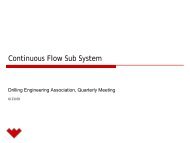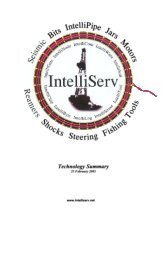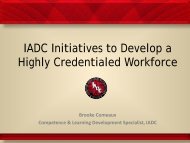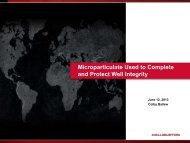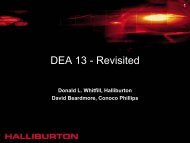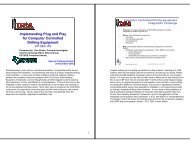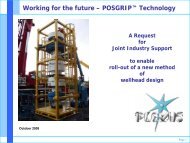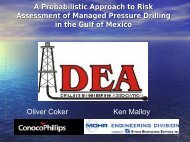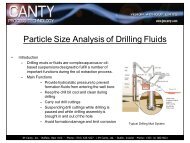Low Frequency Drill Bit Seismic While Drilling - Drilling Engineering ...
Low Frequency Drill Bit Seismic While Drilling - Drilling Engineering ...
Low Frequency Drill Bit Seismic While Drilling - Drilling Engineering ...
Create successful ePaper yourself
Turn your PDF publications into a flip-book with our unique Google optimized e-Paper software.
<strong>Low</strong> <strong>Frequency</strong> <strong>Drill</strong> <strong>Bit</strong><br />
<strong>Seismic</strong> <strong>While</strong> <strong>Drill</strong>ing (SWD)<br />
DEA Discussion Item<br />
November 20, 2008<br />
Oxy Petroleum<br />
Bob Radtke<br />
Technology International, Inc.<br />
radtke@kingwoodcable.com
Objectives<br />
• Achieve acoustic energy required for <strong>Drill</strong> <strong>Bit</strong><br />
• <strong>Seismic</strong> <strong>While</strong> <strong>Drill</strong>ing at 15,000’ and deeper.<br />
• Build and test prototype tools for laboratory and field<br />
demonstrations.<br />
• Create seismic data for “look ahead of the bit” pore<br />
pressure analysis, geosteering, reservoir model<br />
verification; and bit location and near well bore<br />
diagnostics.<br />
• Commercialize two advanced services<br />
• <strong>Drill</strong> <strong>Bit</strong> <strong>Seismic</strong> <strong>While</strong> <strong>Drill</strong>ing<br />
• Wireline RVSP and Cross-Well Tomography
Preface<br />
10 Technologies to Invest in This Decade<br />
<strong>Drill</strong>ing Completion Production<br />
• Rotary Steerable<br />
• Fixed Cutter <strong>Bit</strong>s<br />
• Shock & Vibration<br />
• <strong>Seismic</strong> At The<br />
<strong>Bit</strong><br />
• <strong>Drill</strong>ing With<br />
Casing<br />
• Coiled Tubing<br />
<strong>Drill</strong>ing<br />
.<br />
• Stimulation<br />
• Proppants<br />
• Well Tractors<br />
Richard Spears<br />
Spears & Associates, Inc.<br />
Tulsa, OK<br />
• ESP
Motivation<br />
“The time is coming when we will not drill<br />
without looking ahead of the bit -<br />
anymore than we would drive at night<br />
without headlights occasionally shining a<br />
lamp to see what we hit.”<br />
Mike Tweedy, Chevron
<strong>Drill</strong> <strong>Bit</strong> <strong>Seismic</strong> <strong>While</strong> <strong>Drill</strong>ing<br />
and Cross Well Tomography<br />
• <strong>Drill</strong> <strong>Bit</strong> <strong>Seismic</strong> <strong>While</strong><br />
<strong>Drill</strong>ing<br />
• Using drill-bit noise to<br />
create a velocity profile<br />
while drilling<br />
• Data Processing<br />
• Pore pressure ahead<br />
of the bit<br />
• Geosteering<br />
• Reservoir model<br />
verification<br />
• RSVP and Cross Well<br />
Tomography<br />
• Wireline<br />
• Data Processing
Economic Benefits<br />
• Health, safety, and environmental (HSE) risks<br />
will be decreased.<br />
• Casing related costs and dependence on<br />
contingency casing strings will be reduced.<br />
• <strong>Low</strong>er drilling costs by optimizing mud<br />
weights and assisting safe underbalanced<br />
drilling.<br />
• Accurate pore pressure prediction will<br />
minimize non-productive time (NPT).<br />
• Reservoir model verification
Historical Overview<br />
of <strong>Drill</strong> <strong>Bit</strong> SWD<br />
• 1989:Roller <strong>Drill</strong> <strong>Bit</strong> SWD by Rector and Marion<br />
• 1990:Roller <strong>Bit</strong> Source SEISBIT & TOMEX<br />
• 2002:GRI PDC <strong>Drill</strong> <strong>Bit</strong> SWD Feasibility Study<br />
• Identified Candidate <strong>Drill</strong> <strong>Bit</strong> <strong>Seismic</strong> Sources<br />
• 2007:SPE/EAGE SWD Emerging Technology<br />
Workshops Held in both Dublin and Houston<br />
• 2008:TII Discovered <strong>Seismic</strong>PULSER<br />
Technologies<br />
• Proved 2, 3, 4, 5, 6, and 7 Hz and greater<br />
peaks could be generated with an otherwise<br />
high frequency sparker in the laboratory<br />
• Successfully transmitted low frequencies<br />
from 4000 feet at RMOTC with capability to<br />
15,000+
Laboratory Sparker Testing
Sparker Principle of<br />
Operation
Sparker <strong>Frequency</strong> Spectrum<br />
Conventional Sparker<br />
High Frequencies<br />
<strong>Seismic</strong>PULSER<br />
5 Hz Peak <strong>Frequency</strong>
RMOTC <strong>Low</strong> <strong>Frequency</strong><br />
<strong>Seismic</strong>PULSER Sparker
<strong>Seismic</strong> Survey at RMOTC<br />
Background Rig Noise<br />
<strong>Seismic</strong>PULSER at 3.3 Hz
Conclusions and<br />
Recommendations<br />
• Conclusions<br />
• Revolutionary<br />
<strong>Seismic</strong>PULSER<br />
technologies will provide<br />
low frequency acoustic<br />
augmentation needed for<br />
deep HPHT wells.<br />
For more information<br />
Contact Bob Radtke<br />
radtke@kingwoodcable.com<br />
• Recommendations<br />
• Evolutionary advances<br />
will be discovered in:<br />
• Test wells to generate<br />
seismic data<br />
• Field tests to verify<br />
performance in both<br />
wireline cased hole and<br />
drilling applications.



